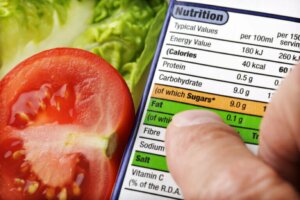Tips for Learning How to Read Nutrition Labels

The tool consumers have to understand if a product is healthy or not is nutrition labels. However, ignorance works against you when choosing healthy products. What should we look for?
What should nutrition labels include?
Food labeling is regulated through the Food and Drug Administration. It establishes the basic requirements that govern food information in the US. In addition, product labels guarantee consumers’ rights to information so they can make educated decisions.
Packaged foods must state with words and numbers, or by figures and symbols, the following:
- Name of the food
- List of ingredients
- All notifiable allergens that are present or used in the manufacture of food, even in small quantities or potential traces.
- The net amount of food
- Minimum duration date or expiration date
- Special conditions of conservation and use
- Basic information on the operator of the food company
- Place of origin
- How to use, in case not having this information could lead to inappropriate use of the food.

Nutri-score
Nutri-score is a food classification system whose goal is to help consumers choose the healthiest within a range of products.
It consists of a “traffic light” of five colors, from green to red. Depending on the number of sugars, saturated fats, salts, calories, fiber, and protein in each food, the system assigns it a color. Healthy foods are a distinctive green, and unhealthy foods are red.
This classification system is more advanced than the previous labeling, but it has certain limitations. One of them is that if you don’t have basic nutrition education, it can be confusing.
Ingredients
The ingredients are always in order from highest to lowest quantity on the labels. This helps you know if an important ingredient is higher or lower than a superfluous one. Also, it’s important to make sure that what you’re buying is really what you’re looking for, not just what the company wants to sell.
In this list, it also needs to state the percentages and origins of ingredients.
Allergens
Nutrition labels must state allergens with a different typeface that differentiates them from other ingredients. For example, they might write them in bold, underlined, capital letters, etc. If there isn’t a list of ingredients on the wrapper, the label will have to reflect the allergens by stating, “contains…”.
Salt
The maximum daily intake of salt should be 5 grams, which is about 2 grams of sodium. To convert this, you can use this formula: grams of sodium x 2.5 = g salt. Remember, a low-salt diet should have at most, one gram of salt daily.
General tips for reading nutrition labels
- If it doesn’t have a label, even better! This means that the raw material is being purchased directly. Therefore, it avoids ultra-processing.
- There’s no need to take into account the advertising about a product. Just because it’s on TV doesn’t make it healthy. Also, beware of terms such as, “functional” or “digestive” because they don’t always provide benefits.
- Be careful with the nutritional and health statements. In other words, consider them extra information, but not the reason to buy a product. For example, it’s okay to see that cereal is rich in fiber, but that doesn’t mean it’s automatically healthy.
Finally, keep in mind that the nutrition labels provide information about quantity, not quality. Therefore, you always need to check the ingredients list.
The tool consumers have to understand if a product is healthy or not is nutrition labels. However, ignorance works against you when choosing healthy products. What should we look for?
What should nutrition labels include?
Food labeling is regulated through the Food and Drug Administration. It establishes the basic requirements that govern food information in the US. In addition, product labels guarantee consumers’ rights to information so they can make educated decisions.
Packaged foods must state with words and numbers, or by figures and symbols, the following:
- Name of the food
- List of ingredients
- All notifiable allergens that are present or used in the manufacture of food, even in small quantities or potential traces.
- The net amount of food
- Minimum duration date or expiration date
- Special conditions of conservation and use
- Basic information on the operator of the food company
- Place of origin
- How to use, in case not having this information could lead to inappropriate use of the food.

Nutri-score
Nutri-score is a food classification system whose goal is to help consumers choose the healthiest within a range of products.
It consists of a “traffic light” of five colors, from green to red. Depending on the number of sugars, saturated fats, salts, calories, fiber, and protein in each food, the system assigns it a color. Healthy foods are a distinctive green, and unhealthy foods are red.
This classification system is more advanced than the previous labeling, but it has certain limitations. One of them is that if you don’t have basic nutrition education, it can be confusing.
Ingredients
The ingredients are always in order from highest to lowest quantity on the labels. This helps you know if an important ingredient is higher or lower than a superfluous one. Also, it’s important to make sure that what you’re buying is really what you’re looking for, not just what the company wants to sell.
In this list, it also needs to state the percentages and origins of ingredients.
Allergens
Nutrition labels must state allergens with a different typeface that differentiates them from other ingredients. For example, they might write them in bold, underlined, capital letters, etc. If there isn’t a list of ingredients on the wrapper, the label will have to reflect the allergens by stating, “contains…”.
Salt
The maximum daily intake of salt should be 5 grams, which is about 2 grams of sodium. To convert this, you can use this formula: grams of sodium x 2.5 = g salt. Remember, a low-salt diet should have at most, one gram of salt daily.
General tips for reading nutrition labels
- If it doesn’t have a label, even better! This means that the raw material is being purchased directly. Therefore, it avoids ultra-processing.
- There’s no need to take into account the advertising about a product. Just because it’s on TV doesn’t make it healthy. Also, beware of terms such as, “functional” or “digestive” because they don’t always provide benefits.
- Be careful with the nutritional and health statements. In other words, consider them extra information, but not the reason to buy a product. For example, it’s okay to see that cereal is rich in fiber, but that doesn’t mean it’s automatically healthy.
Finally, keep in mind that the nutrition labels provide information about quantity, not quality. Therefore, you always need to check the ingredients list.
All cited sources were thoroughly reviewed by our team to ensure their quality, reliability, currency, and validity. The bibliography of this article was considered reliable and of academic or scientific accuracy.
- Reglamento Europeo Nº 1169/2011 sobre la información alimentaria facilitada al consumidor. 2018. http://www.aecosan.msssi.gob.es/AECOSAN/web/seguridad_alimentaria/subdetalle/futura_legislacion.htm
- NIH National Institute of Aging. Reading Food Labels. https://www.nia.nih.gov/health/reading-food-labels
This text is provided for informational purposes only and does not replace consultation with a professional. If in doubt, consult your specialist.








